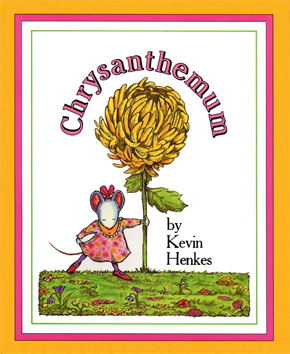
Title: Chrysanthemum
Author: Kevin Henkes
Publisher: Greenwillow Books (1991)
Pages: 30
Genre: Fiction
The story follows the young mouse Chrysanthemum and her transition into school. At first, Chrysanthemum loves her name, but then she goes to school where the other children tease her about her name. Chrysanthemum is saddened by these jeers and always needs to be cheered up, but fortunately it takes one person to say that such a name is beautiful, and the children learn to accept other long names and Chrysanthemum feels empowered.
In the beginning Chrysanthemum takes up a majority of the frames that she is in. She’s confident, she’s happy and she loves her name, really she loves herself. Her love for her name shows the capacity for self-love and confidence and this attitude is nurtured by her parents. When she goes to school however, she is teased by her name. She is described as “wilted” as a flower does when it is dying. The children kill her self-esteem in this way; they are metaphorically taking life away from her as they tease her. Moreover, she is shown as small in the frame with the very imposing Victoria as a clearly larger character and her two side-kicks, Jo and Rita, are always in toe
Two times Chrysanthemum’s parents must cheer her up after she returns from school, with diminishing returns as each consolation make her feel better, but less and less each time. Additionally, Victoria on both of these consequent days feels necessary to point out her jeers toward the Chrysanthemum to the teacher. The teacher, however, blithely responds with “thank you for sharing.” This definitely leads itself to teach children how adults can be complacent in bullying as well.
In contrast to this, however, the Music teacher, Mrs. Twinkle, demonstrates her namesake. She is a vibrant teacher who is wildly popular with the children and upon hearing the teasing of Chrysanthemum, intervenes. Upon her intervention Victoria once again announces her jeers as a fact that must be heard. Mrs. Twinkle, however, falls into all the categories of those jests herself. This shows one, a responsible adult who engages with the students’ activities and two, that people can use their position to benefit others. Mrs. Twinkle, being popular with all the children, has sway and influence on how they behave, so one gets the sense that this is the right thing to do because it benefits all and breaks down social berries. Although Mrs. Twinkle is an adult, it could and should be pointed out that adults aren’t the only ones that have influence like this, Victoria is her contrast, for example. But, again, the class teacher Mrs. Chud is shown to take an apathetic side to this sequence of event, it is important, I think to highlight this fact, and to show that sometimes adults can make mistakes too and maybe even need to be told about their complacency in lieu of what’s right.
